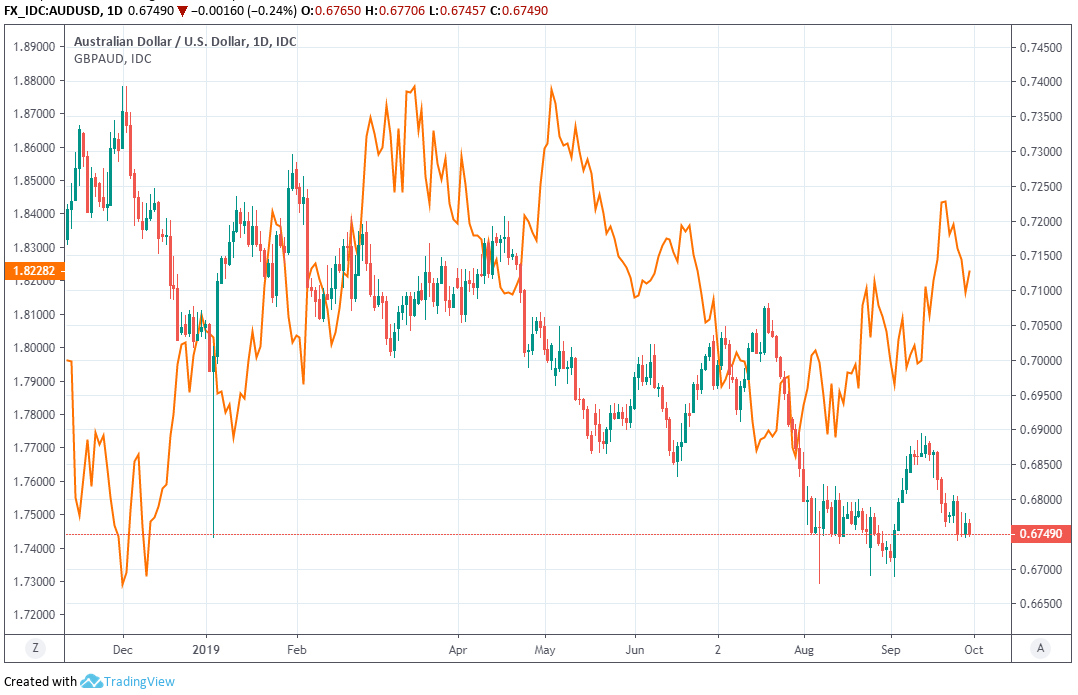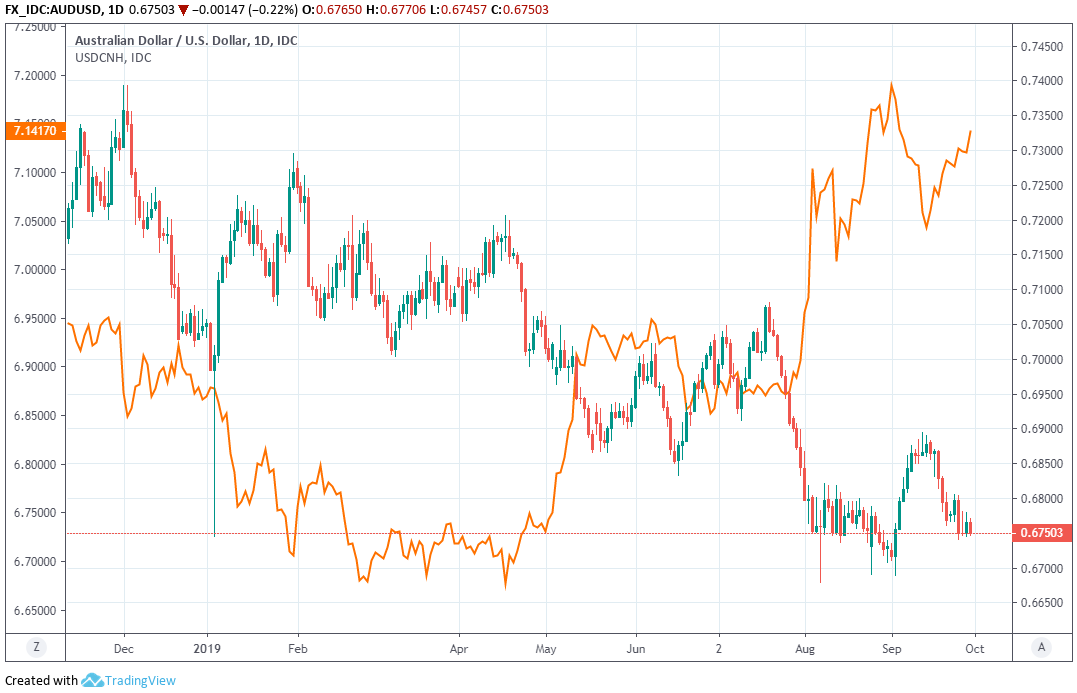The Australian Dollar Could be in for an RBA Surprise Tuesday
- Written by: James Skinner
-

Image © Crawford Forum, Reproduced Under CC Licensing
- AUD softens on renewed trade war fears, ahead of RBA decision.
- RBA widely expected to cut rates on Tuesday amid some dissent.
- RBC and ING warn there's a risk that RBA does not cut in October.
- Say AUD would bounce higher if rates remain on hold this month.
- But renewed China tensions could see gains limited and short-lived.
The Australian Dollar was softer Monday amid renewed trade tensions and ahead of the latest interest rate decision from the Reserve Bank of Australia (RBA), although some analysts are warning the bank could surprise the market on Tuesday, leading the antipodean currency to bounce higher.
Consensus is for the RBA to cut its cash rate to a new record low of 0.75% at 05:30 on Tuesday, marking the third cut this year, in an effort to lift inflation back to the 2%-to-3% target by stimulating the economy with lower borrowing costs for companies and households.
"Our economists are in the minority looking for no change (20-7 for a cut in the Bloomberg survey), though they acknowledge it is a close call and note the RBA often delivers what is priced by the market, especially if a cut is likely at some point before year end so a move would probably not be surprising," says Adam Cole, chief FX strategist at RBC Capital Markets.
The overnight-index-swap market, which enables investors to protect themselves against as well as speculate on changes in rates, implied on Monday, an October 01 cash rate of 0.80%. That's above the 0.75% that'll prevail if the RBA cuts Tuesday, but it's close enough to it to mean that if RBA was eschew a rate cut Tuesday, then the Aussie Dollar could bounce sharply.
Changes in rates are normally only made in response to movements in inflation, which is sensitive to GDP growth, but impact currencies because capital flows tend to move in the direction of the most advantageous or improving returns. Those flows tend to move in the direction of the most advantageous or improving returns, with a threat of lower rates normally seeing investors driven out of and deterred away from a currency.
"Markets, as well as the consensus of economists, are braying for more easing. The OIS curve shows an implied probability of a rate cut this week at 80%. And failure by the RBA to deliver a cut at this week's meeting will likely see the AUD spike higher," says Chris Turner, head of FX strategy at ING.

Above: AUD/USD rate at daily intervals, alongside GBP/AUD rate (orange line, left axis).
RBA Governor Philip Lowe hailed a perceived turning point for the Aussie economy in a speech to the Armidale Business Chamber last week, leading markets to believe there was some chance the bank could eschew a rate cut this Tuesday. The speech was the latest in a growing line of remarks that have sent mixed messages about the RBA's thinking on the rate outlook.
Previously the RBA revealed in minutes of its August policy meeting that policymakers wanted to see "an accumulation of additional evidence" that more easing is necessary before cutting rates again, only for that particular line to then be omitted from minutes of the September meeting. Since August, retail sales figures for July have disappointed markets and GDP growth figures for the second quarter have confirmed a continued economic slowdown down under.
"OIS markets are pricing a 77% chance the RBA will cut the cash rate by 25bps to 0.75% overnight (5:30am London time). We expect the RBA to cut the cash rate because labour market slack is increasing. Our previous research indicates AUD could jump by 0.4% if the RBA does not cut. We are wary of this risk," says Kim Mundy, a strategist at Commonwealth Bank of Australia (CBA).
Lowe's statement last week could be taken to mean the RBA sees another rate cut as uneccesary, but he also said in the very same speech that a rise in Aussie Dollar would be "unhelpful in terms of achieving both the inflation target and full employment", which is exactly what the Governor would get if the RBA doesn't cut. Lowe has also said repeatedly that all of the RBA's forecasts are "conditioned upon the assumption" the cash rate follows what is priced into markets. Those two things should mean a Tuesday cut is all but a done deal.

Above: AUD/USD rate at daily intervals, alongside GBP/AUD rate (orange line, left axis).
"Whichever way we look at it: there is disagreement about which way the RBA’s decision tomorrow will go. As a result, we should see a considerable reaction in AUD exchange rates whatever happens," says Ulrich Leuchtmann, head of FX strategy at Commerzbank.
Tuesday's decision will come amid fresh trade tensions, which are stoking increased fears for a global economy that has already been badly damaged by the 18-month long tariff fight between the U.S. and China.
Bloomberg News reported Friday that President Donald Trump is contemplating limiting portfolio flows to China, an aggressive step that would mark a significant escalation of the trade war. He's also reportedly mulling restrictions on Chinese companies' access to U.S. stock markets too.
Restricting 'portfolio flows' would involve limiting the amount of debt and stock that American money managers can buy in China. Foreign holdings of Chinese stocks and bonds remain small but strong earlier growth in the world's second largest economy has left it increasingly in need of outside capital, which is why the country has begun to relax some rules in recent years. President Trump's plans, if gone through with, would put a roadblock in China's path and would amount to something like an act of 'wounding with intent' in the trade war that had seemed to freeze throughout September.
The plans could also have a more pronounced adverse impact on the Australian Dollar too, assuming the full force of them is felt by China's Renminbi. Australia's currency shares a strong positive correlation with the Chinese unit because the large commodity trade between the two countries means their economic fortunes are to a significant extent, intertwined. Fears for China's economy can reduce prices of commodities that Australia sells and falling demand from China, resulting from actual economic damage, takes food right off of Australia's table.

Above: AUD/USD rate at daily intervals alongside USD/CNH. Demonstrates AUD-CNH correlation.
Time to move your money? Get 3-5% more currency than your bank would offer by using the services of foreign exchange specialists at RationalFX. A specialist broker can deliver you an exchange rate closer to the real market rate, thereby saving you substantial quantities of currency. Find out more here.
* Advertisement





